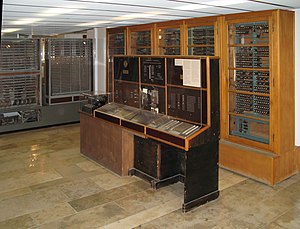The computer - my life's work
The Computer - My Life's Work is the title of the autobiographical book written in 1969 by the computer pioneer Konrad Zuse (1910–1995), in which the author traces the development of computer technology with special consideration of his own contributions.
from the content
Motivated by the laborious static calculations of a civil engineer , the student Konrad Zuse developed his first thoughts on a program-controlled mechanization of this work. In 1936 this led to a mechanical, binary working machine with a likewise mechanical data memory . After some explanations about relays , all kinds of circuits, adding units , propositional logic and Helmut Schreyer's idea for an electronic solution, the author describes the beginning of the development of calculating machines. The demonstration of the computing machine Z2 , which is said to have worked properly only during this demonstration, aroused the interest of the German laboratory for aviation , so that in 1941 the paper tape -controlled, binary with sliding comma working Z3 was completed, which was used for calculating aircraft wing properties . From 1942 Zuse worked on an improved model Z4 , which was a difficult undertaking under war conditions.

In some places Konrad Zuse emphasizes his negative attitude towards National Socialism , but writes in the section " Continuing the work with all sorts of difficulties "
- “It should be emphasized today that you were opponents of the Nazi regime. I wasn't a "Nazi"; but I openly admit that, in view of the bombing war on the German civilian population, I did not see my task in sabotaging efforts to build anti-aircraft missiles. "
Together with some employees of the company " Zuse Apparatebau Berlin " and the almost completed Z4, Zuse fled Berlin via the intermediate station in Göttingen to Oberjoch , where he met with Wernher von Braun , who had also fled there. At the end of the war, the Z4 was in a shed in the Allgäu , all previous models had been destroyed in the war.
This is followed by considerations about the required performance of the planned machine, for example to be able to master the game of chess, and about the Plankalkül developed by Zuse , which would be called a programming language today. After philosophical considerations, the author draws a comparison with the American developments, in particular with the Mark I and ENIAC machines , which he only found out about due to the war, and the theoretical work of Shannon and Turing was also unknown to him until now. The attempt to have his inventions patented failed; In 1967 there was finally a negative decision due to a lack of inventiveness .
Interest in Zuse's machines increased after the end of the war, and in 1949 he founded Zuse KG in Neukirchen . The rescued Z4 was installed at ETH Zurich in 1950 , at that time it was the only computer in use on mainland Europe and ran there until 1955. The five-year rental of the Z4 by ETH Zurich and the follow-up order from the Swiss Remington-Rand for the computer punch M9 / Z9 formed the economic basis for building up Zuse KG. The Z4 then came to Saint-Louis near Basel. The first post-war order was the Z5 for the Ernst Leitz company in Wetzlar . After the Z11 , which was still based on relay technology , the first electronic version Z22 , which was ready for production in 1955, was also an economic success. The company developed the first plotter in 1959 with the Graphomat Z64 . There is also talk of economic aberrations, such as the failed attempt to build an inexpensive Z31 small computer or the unaffordable development of a production monitoring system known as the Z70. Zuse describes the rapid development of the use of computers in science and industry, the further expansion of his company and describes the problems that occurred during expansion up to his own departure from management in 1964. The book ends with an outlook on the future developments of the computer.
Remarks
The book was first published in 1970 by “Verlag Moderne Industrie” and was published by Springer in 2010 for the 100th birthday of Zuse. The Springer editions have a slightly different chapter structure and have scientific attachments, including excerpts from the lecture on the occasion of the award of an honorary doctorate by the Technical University of Berlin . In 1993 Springer published the English translation The Computer - My Life .
literature
- Konrad Zuse: The computer is my life's work. Verlag Moderne Industrie, 1970.
- Konrad Zuse: The computer - my life's work . 3. Edition. Springer, Berlin 1984, ISBN 3-540-13814-5 ( excerpts , first concept from 1968 as PDF (51.9 MB)).
- Konrad Zuse: The Computer - My Life. Springer, Berlin 1993, ISBN 3-540-56453-5 .
- Konrad Zuse: The computer - my life's work. 5th edition. Springer, Berlin 2010, ISBN 978-3-642-12095-4 .